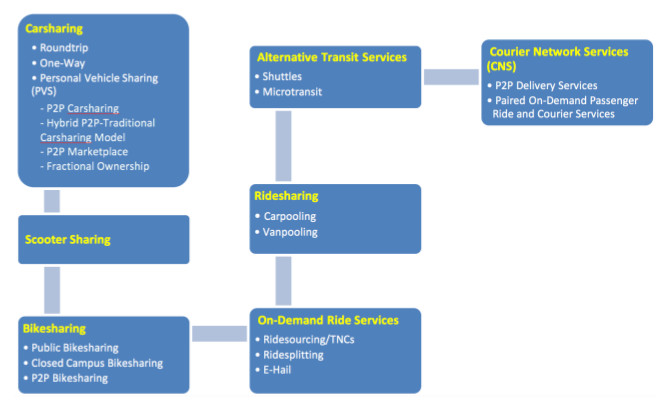TSRC’s latest white paper is a background and summary report on shared mobility services in the United States.
The latest white paper from University of California, Berkeley’s Transportation Sustainability Research Center is a primer on shared mobility in the United States. Co-authored by Susan Shaheen, Nelson Chan, Apaar Bansal, and Adam Cohen, Shared Mobility: Definitions, Industry Developments, and Early Understanding organizes the current field of shared transportation services into seven categories, and offers a description and summary of proven or potential environmental, economic, and social benefits associated with each. A concise overview of the contemporary shared mobility sector, the paper, which also includes a section on trip planning apps, establishes a common ground upon which sharing-economy activists, transportation researchers, urban planners, and policymakers can build.
The sharing economy, the authors of Shared Mobility observe, has revolutionized the way we think about transportation ownership. While the personal vehicle still looms large, the existence of an increasingly diverse array of mobility modes has prompted many Americans—especially younger, highly-educated urbanites—to rethink their own approach to getting around. At the same time, innovations including bikesharing and carsharing represent potential answers to three priorities shared by many local and regional transportation agencies: increasing use, maximizing system efficiency, and lessening environmental impacts.
This year, we’ve seen Mutual Aid in Motion.
From scaling sharing hubs to Mutual Aid 101 trainings, we’re helping communities build the tools they need.
Every dollar fuels lasting resilience – proving that when we move together, we all move forward.

Shared Mobility organizes shared transportation modes into seven categories.
Research on shared mobility is necessarily in its infant stage, given the relative newness of most shared transportation modes. A number of benefits have nonetheless been consistently documented, including reduced levels of vehicle ownership, usage, and vehicle miles traveled (VMT). In addition, the authors of Shared Mobility point out, potential benefits including eliminating gaps in existing transit networks (including the critical first- and last-mile vacancies) and reducing transportation costs for households and individuals.
Shared Mobility gestures towards these and other benefits in sections dedicated to each of seven shared-mobility categories: carsharing, scooter sharing, bikesharing, on-demand ride services, ridesharing, alternative transit services, and courier network services. Each section defines the category at hand, sometimes breaking the same into sub-categories (“on-demand ride services,” for instance, include ridesourcing like Uber and Lyft, ridesplitting, and e-hail services), before briefly summarizing any relevant research. The paper’s final section, on trip-planning apps, highlights a selection of apps designed to help users navigate one or more shared mobility modes. Four appendices include a glossary of terms and summaries of some of the services discussed in the body of the paper.
Rather than offering deep analysis or presenting new research, Shared Mobility is strictly a background and summary report. It nevertheless importantly advances the conversation on shared mobility. By eliminating the need to reinvent the (shared) wheel—and by affirming activists’ conviction that shared transportation services can deliver benefits to both individuals and communities—this indispensible white paper sets the stage for continued investigations into the range of alternative transit modes available to contemporary commuters.

The paper summarizes the impacts of several shared mobility innovations, including ridesourcing.

